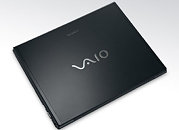Saturday, October 13th 2007

Sony VAIO G21 Laptop Announced
Sony's European subsidiary unveiled today VAIO G21 for managers and professionals. The 12.1-inch XGA (1024x768) LED backlit laptop consumes less power due to Intel ULV processor and provides 7 hours of battery life. The firm even claims the laptop can go up to 11.5 hours with a high-capacity battery. The carbon-fibered 1kg VAIO G21 notebook comes in two models - the VGN-G21VN / B and the VGNG21XP / B. The first one ($2,976) features 1.06GHz Intel Core 2 Duo U7500 processor, up to 2GB RAM, 64GB SSD hard drive, Intel GMA 950 graphics with 224MB memory, 802.11a/b/g wireless, Bluetooth, fingerprint reader, and Microsoft Windows Vista OS. The VGNG21XP / B has similar specs except the 100GB hard drive (no SSD), and 1GB RAM.
Sources:
Notebook Italia, PCLaunches

8 Comments on Sony VAIO G21 Laptop Announced
And plus, solid-state HDDs have not yet established themselves as reliable media for storage of mission-critical data, most flash-drives today don't work beyond an year. But atleast this seems to be a tad safer than a spinning HDD that damages to a drop.
1./ Sleek and stylish
2./ Good battery life
3./ Powerful (for an ultraportable) ; (Note will enthusiasts pls STOP complaining about the speed of an ultra. No "executive" is buying the device to play games on or use it for burning movies etc.)
4./ Slim and light weight
But there are still two major problems with the whole range of SONY
1./ Ultrablack = Ultra-reflective display that is TOTALLY unusable in an office envirnment where window light, or multiple ceiling lights reflect on the screen
2./ The resolution is POOR for the modern day OS. We all use 2000/XP/2003/Vista or similar, and we want clear-type or antialias fonts and icons. The 1024x768 is just too low res. They need a high def. screen, e.g. 1280x1024 or better in a small 12.1 format. Not for very making the writing and fonts small, but for making what IS SHOWN, a higher resolution.
It runs a Cell processor, and many people have it in their homes.
Most office workers might not mind using Linux, and the Cell processor in the PS3 runs hot and wastes energy, bt mated with lower-powered devices, and running at slower speeds, it should still be able to crunch some numbers, and possibly be suitable for maybe a 15" laptop. While a desktop PC based around one would likely be suitable to run two of them, at the same speeds as a PS3, and relatively quietly, and cool (what with watercooling and such cooling options)
Oh, and there are distributed computing rooms in Universities running off several PS3s connected together, providing huge power for little cost, and low-ish power usage.
I wish sony can drop their laptop prices. Still cost to much money, but they do look nice!